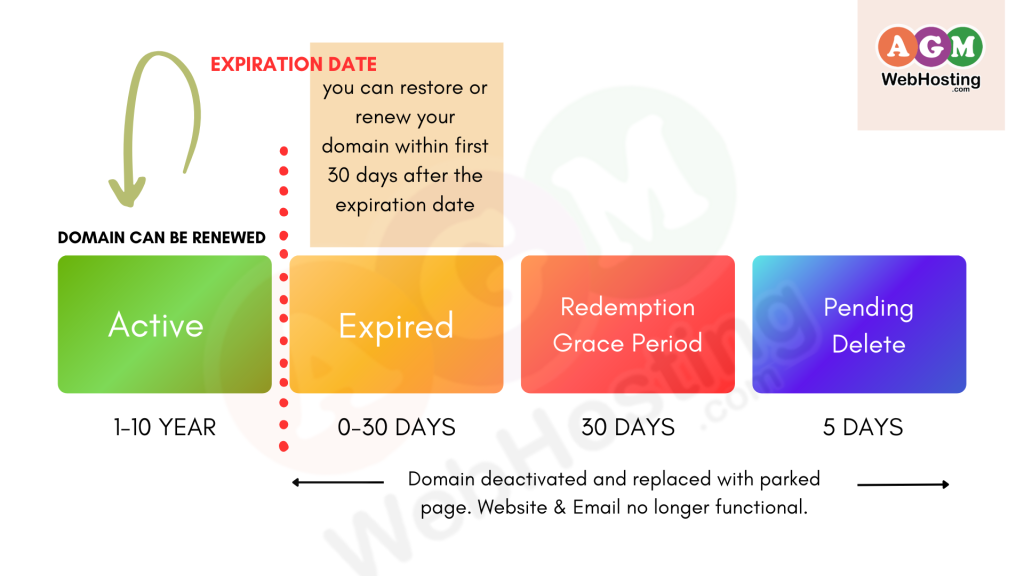
Oops! You accidentally let your domain name get expired.
So what happens next?
Every year, the number of domain names across all top-level domains (TLDs) registered or renewed is in the millions. On the other hand, millions expired as well. The reason behind this is that every domain name goes through a life cycle. Understanding the domain name life cycle is extremely important for anyone who owns the domain name to prevent any inconveniences it brings with expired domain names.
Has the domain name you own got expired?
Fret not, in this article, you will learn everything about the domain name life cycle. This should help you to comprehend the concepts about what happens when your domain name expires thoroughly.
Domain Name Life Cycle – Full Explanation
Table of Contents
What is Domain Name Life Cycle?
The domain name life cycle is the different phases that a domain name goes through to stay active – from its registration to expiry and eventual deletion.
Generally, a domain name can have five different phases, namely:
- Available for Registration
- Registered and Active
- Expired and Grace Period
- Redemption Period
- Pending Delete
Most Top Level Domain extensions follow the same common process, but some of it is based on which registry manages the domain extension and how long ago it expired. Here we’ll be covering the estimated domain lifecycle timeline for the .com domain. However, it may not apply for certain extensions such as ccTLDs(country-code Top-Level Domains), as this category of domain most often has its own life cycle as determined by their respective governing countries. Some examples of such ccTLDs include .np, .au, .in, etc.
The Internet Corporation for Assigned Names and Numbers (ICANN) adopted the Expired Registration Recovery Policy on Aug. 31, 2013. The policy requires registrars to notify registrants of important information regarding expiration notices, redemption procedures, and fees.
Please note if the domain is a few days past the expiration date the domain is not lost forever. Additionally, buyers out there who think they can just wait until the clock strikes 12 the day the domain expires with the idea they can immediately scoop the domain up must understand that this is simply not possible. Hiring a professional to help you navigate this process might be the best thing you can do.
Five Phases of Domain Name Life Cycle

Available for Registration
During this phase of the domain name life cycle, you can search for the availability of a domain name to be registered by a registrar. If it’s available, this means the domain name is available to be registered by a registrar and has not been registered by any entity. When a domain name is available, you can register it online via any domain name service provider. Domains have a minimum registration/renewal period of one year, though some domains may require more. Domains can be registered and renewed for up to a total of 10 years at a time with us.
Registered and Active
The domain has now been registered and is in active status. The domain will be registered for 1 year in most cases before needing renewal. While your domain is Active, you can modify its settings and contact information. Keeping an active domain helps you keep your website online and your email working.
In order to keep your domain active, we strongly encourage you to enable automatic domain renewal service with the client area so that you won’t miss any renewals.
Expired and Grace Period
If the domain name is not renewed by the renewal date advised, the domain expires and will no longer function and the email stops working. This expiry phase allows a grace period of maximum 30 days for the domain to be renewed after the expiry date. Renewing your domain during the grace period allows your website and email to start functioning again. At this phase, you can still renew your domain at the normal domain renewal rates so long as it hasn’t reached the Redemption Period Phase.
Important: As soon as your domain expires, it can be purchased or bid for by a 3rd party. You still have priority for renewing your domain so long as you renew your domain within 30 days of its expiration date, even if purchases or bids have been placed toward your domain. However, if you still haven’t renewed your domain within those 30 days and a 3rd party purchases your domain, you lose the domain and will no longer be able to renew it.
Redemption Period
If you still haven’t renewed your domain within those 30 days’ Grace Period phase of the domain name, it typically enters the Redemption period. You can also check the status of the domain in WHOIS by inserting the domain name into the ‘Enter domain or IP’ Search Tab. Then you can view the required information within the domain information section. However, certain top-level domains may enter the redemption phase the day after the domain’s expiration date. During this phase, the domain can be renewed but additional fees will apply. The redemption fee will cost up to $160.00 USD.
While every registrar handles the redemption period differently, the redemption period commonly lasts for 30 days until the domain enters Pending Deletion status.
Pending Deletion
Once a domain enters Pending Deletion status, the expired domain will typically be marked “Pending Delete” in WHOIS and can no longer be redeemed in any way. You will lose the domain forever. The domain will be held for about five days before it is released by the registry. And then it will be made publicly available for new registration. Once the domain is available for new registration again, it can be registered at the normal domain registration rates (no redemption fees will apply).
If you’re lucky enough, then you can newly register the expired domain after it’s available publicly to register again.
Key Takeaways
Your domain is the foundation, it’s your brand, your front door, and the basis of your company’s communications. Failing to renew your domain name may benefit your competitors or any other parties thus resulting in much hassle.
Understanding the domain name life cycle can help you a lot to manage your domain name and the consequences of letting your domain name expire.
How do you keep from letting your domain expire?
Call us today!
Renew it to the min 1 year to the max, which is 10 years, and then leave another 10-year’s worth of renewals as a credit in the account. It sounds like overkill, but for what the domain means to your online business, it is the cheapest insurance policy you will ever own.
Please note that all the timelines in this article are estimates. Many of the factors mentioned in this post are just beyond our control. AGM Web Hosting makes no guarantees that the above timelines and procedures will precisely occur in all cases.
